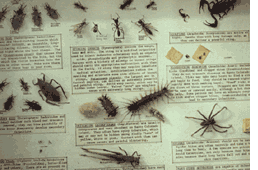
-----

Disease and Pestilence
"Historically, the canal area was infested with creatures ranging from the simply annoying to the dangerous: boa constrictors, coral snakes, chiggers, spiders, and inch-long Paraponera clavata, ants with a sting like a cattle-prod shock.
"Early travelers to BCI faced parasites and strange viruses, fungal and bacterial infections. Up to the time the Americans, with their mosquito-eradication programs, began work on the canal, plagues of tuberculosis, smallpox, cholera, yellow fever, and malaria devastated towns and villages.
"Today, most of this pestilence is irrelevant to BCI's residents. But the forest is still home to plenty of stuff that can bite. There are urticating caterpillars, for example, whose hairs pierce the skin and cause itching, burning, and welts; there's leptospirosis, which if not treated may result in kidney damage, meningitis, liver failure and, eventually, death; and Chagas disease, transmitted by assassin beetles--kissing bugs--which congregated near the laundry room. This disease is spread when an infected insect bites a sleeping person, usually near his mouth. The victim, sensing the bite, then rubs the feces into the tiny wound. Those who contract Chagas may not even know it for ten to twenty years, when the chronic symptoms--cardiac problems and an enlarged digestive tract--kick in."
 Cockroaches
Cockroaches
Edward O. Wilson is, in an indirect way, responsible for me first visiting Barro Colorado ten years ago. Known to most as a Harvard professor, a prize-wining author (Conciliance; Naturalist; Biophilia; On Human Nature; The Insect Societies; Sociobiology: The New Synthesis), a top-notch myrmecologist, the godfather of the study of sociobiology, a biodiversity proselytizer and the world's expert on Pheidole--the largest genus of ants in the New World--Wilson is, to me, even more.
On my first night on BCI, my first night in a tropical rain forest, I was greeted by a four-inch-long cockroach, Blaberus giganteus, on my pillow. Freaked but trying to play it cool (I accepted, intellectually, that BCI was host to 100 varieties of cockroach), I climbed up to the dining hall hoping to sweet-talk a sympathetic grad student into removing it for me. Instead, I bumped into Wilson.
"Ah, Miss Royte," he said. "What brings you up here at this hour?" I was embarrassed by my wimpiness, but I told him about my problem. He said, without hesitation, "Let's see what we can do about that."
Did I mention that Wilson is famously, insanely polite? Though his back was hurting him, and he'd been traveling all day, and he was en route to his own cabin, he insisted on detouring to mine. I felt honored, but also a little guilty. Asking an entomologist on the order of E.O. Wilson to eradicate a cockroach is like asking Frank Lloyd Wright to take a look at one's leaky roof.
The cockroach had scuttled under my mattress, but Wilson knew what to do. In one swift movement, he lifted the thin piece of foam and made a grab for the flailing arthropod. "Got it," he said, holding it aloft with its antennas waving. He dropped it in the toilet--splat!--and flushed.
"I don't think he'll be bothering you anymore," Wilson said, pressing his palms together.
At breakfast, I told the assembled bug jocks about my late-night encounter with Wilson. I described his technique, how he knew where to look for the cockroach, and how he'd done it all bare-handed.
Big deal, was the response I got. The guy's an entomologist. Blaberus is everywhere. So welcome to the Tropics.
Rain
"It was the rainy season now, and all the island streams were flowing, with pools big enough to sit in. The island looked more than ever like a rain forest--shiny green and lush, with sweet-smelling flowers and the sound of trickling water. I saw fruits I'd never seen before--Coccoloba densifrons, with its small yellow berries, and Tontelea richardii, smooth, brown and coconut-sized. The petals of newly flowering trees carpeted the trails.
"Water and warmth made the tropics tropical, and the onset of the rainy season cued so many of BCI's plants to flower and fruit, setting off rhythms that reverberated through all trophic levels. Of course the onset of the dry season sent signals as well, but the rain was the reason all of us--creatures who studied and creatures who got studied--were here. It was the element that literally and metaphorically set the whole thing off.
"Now, rainclouds shuttered out the sun for most of the day. At times, so little light reached the forest floor that it was difficult to make out the words on a map. The island was gloomy sometimes. Depressing. That's when I started to notice the myriad odors of rotting wood and mold. Strange fungi sprouted on the trunks of trees and on spongy logs. There were whitish growths that looked like bean sprouts, blobs of orange with the consistency of jelly.
"Indoors, all this moisture took another kind of toll. Bedsheets felt perpetually damp. My pillow began to smell rank, reminding me of the hundred sweaty heads that had lain here before mine. Chrissy told me to store the pillow in the dry closet by day. This helped some, but sending the pillow through the washer and dryer soon became routine.
"Muddy, wet clothing festooned every dorm's balcony. Ceiling fans ran day and night, to keep the moisture level down. No one discussed the environmental implications of this profligacy. The clank and rattle of backpacks bouncing around the dryers joined the nocturnal chorus of frogs around the laundry room. Some residents who spent their day in damp clothing developed fungal infections, which gave them a strange odor. After a few hours in the field, Chrissy smelled, not unpleasantly, like bran cereal. She treated the condition by washing her body in Head & Shoulders. I was spared this fungus, but others invaded my room. Gray-green mold coated my wallet. The dollar bills were loathsome to touch. My rubber boots were moldy, and my leather sandals too. Rubber Tevas took on an especially noxious odor this time of year. Tampax not stored in Ziplocs exploded, on their own, like milkweed pods in autumn."
Back to top